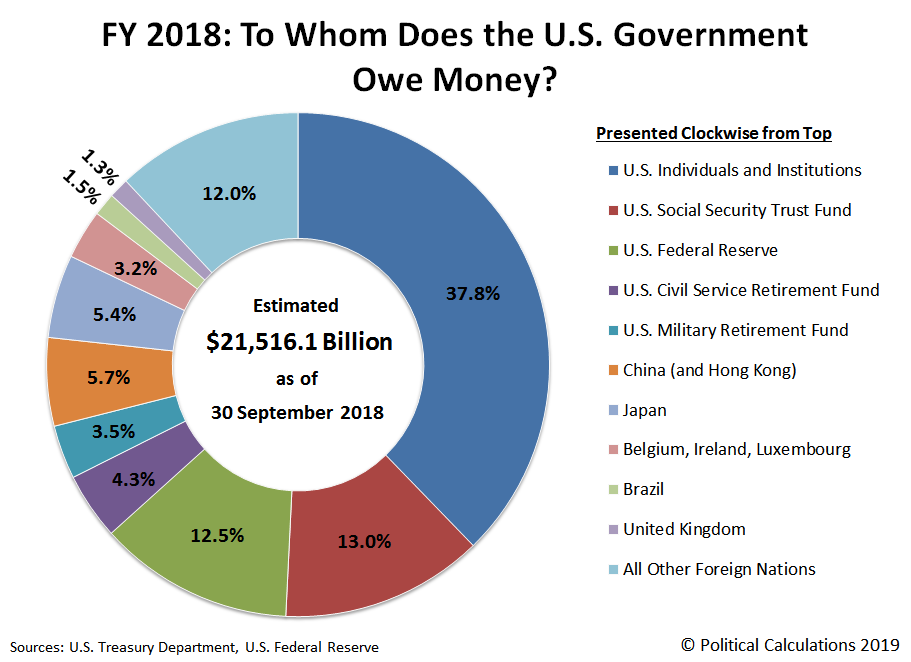The U.S. Treasury Department has revised its estimates of the amount of money the U.S. government owed to various foreign countries, which allows us to finalize the data for the government's fiscal 2018 for which we had presented preliminary figures earlier this year.
From the end of its 2017 fiscal year to the end of its 2018 fiscal year, the U.S. government's total public debt outstanding increased by $1,271 billion, or $1.3 trillion, to reach a total of $21,516 billion, or $21.5 trillion. Put a little bit differently, the U.S. national debt grew at an average rate of nearly $3.5 billion per day on every day of the government's 2018 fiscal year.
That's a very large number, but 2018 was only the sixth largest annual increase for the U.S. national debt in terms of nominal U.S. dollars. Larger increases were recorded during President Obama's tenure in office in 2012 ($1,276 billion), 2010 ($1,294 billion), 2011 ($1,300 billion), 2009 ($1,413 billion), and 2016 ($1,423 billion).
So it's not an accident that the U.S. national debt has risen to $21.5 trillion, where these six years combined account for 37% of the official U.S. national debt. But to whom does the U.S. government all that money?
The following chart breaks down who the U.S. government's major creditors were at the end of its 2018 fiscal year, which is based on preliminary data that will be revised in upcoming months.
According to the U.S. Treasury Department, the U.S. government spent some $779 billion more than it collected in taxes during its 2017 fiscal year. The difference between this figure and the $1,271 billion that the total national debt officially rose can be attributed to the government's net borrowing to fund things like Federal Direct Student Loans, which have combined to account for over $1.2 trillion of the government's $21.5 trillion debt, or 5.7% of the total public debt outstanding since 2010.
Overall, 70% of the U.S. government's total public debt outstanding is held by U.S. individuals and institutions, while 30% is held by foreign entities. For FY2018, China has retained its position as the top foreign holder of U.S. government-issued debt, with directly accounting for 5.7% between institutions on the Chinese mainland and Hong Kong, even though the country has been reducing its holdings of U.S. government-issued debt.
Japan ranks as the second largest foreign holder of the U.S. national debt, with the U.S. owing Japanese institutions 5.4% of its total debt. After that, the European international banking centers of Belgium, Ireland, and Luxembourg combine to account for 3.2% of the U.S. national debt, followed by Brazil at 1.5% and the United Kingdom with 1.3%.
The largest single institution holding U.S. government-issued debt is Social Security's Old Age and Survivors Insurance Trust Fund, which is considered to be an "Intragovernmental" holder of the U.S. national debt, and which holds 13.0% of the nation's total public debt outstanding. The share of the national debt held by Social Security's main trust fund has begun to decline as that government agency cashes out its holdings to pay promised levels of Social Security benefits, where its account is expected to be fully depleted in just 16 years. Under current law, after Social Security's trust fund runs out of money in 2034, all Social Security benefits would be reduced by 23% according to the agency's projections.
The largest single "private" institution that has loaned money to the U.S. government is the U.S. Federal Reserve which, like China, has been reducing its holdings of U.S. government-issued debt. At the end of September 2018, the Fed held 12.5% of the U.S. government's total public debt outstanding. In FY2018, other U.S. institutions such as pension funds and insurance companies have significantly increased their holdings of U.S. government-issued debt as interest rates rose during that year.
Data Sources
U.S. Treasury. The Debt To the Penny and Who Holds It. [Online Application]. 28 September 2018.
Federal Reserve Statistical Release. H.4.1. Factors Affecting Reserve Balances. Release Date: 26 September 2018. [Online Document].
U.S. Treasury. Major Foreign Holders of Treasury Securities. Accessed 15 August 2019.
U.S. Treasury. Monthly Treasury Statement of Receipts and Outlays of the United States Government for Fiscal Year 2018 Through September 30, 2018. [PDF Document].
Labels: national debt
Welcome to the blogosphere's toolchest! Here, unlike other blogs dedicated to analyzing current events, we create easy-to-use, simple tools to do the math related to them so you can get in on the action too! If you would like to learn more about these tools, or if you would like to contribute ideas to develop for this blog, please e-mail us at:
ironman at politicalcalculations
Thanks in advance!
Closing values for previous trading day.
This site is primarily powered by:
CSS Validation
RSS Site Feed
JavaScript
The tools on this site are built using JavaScript. If you would like to learn more, one of the best free resources on the web is available at W3Schools.com.
